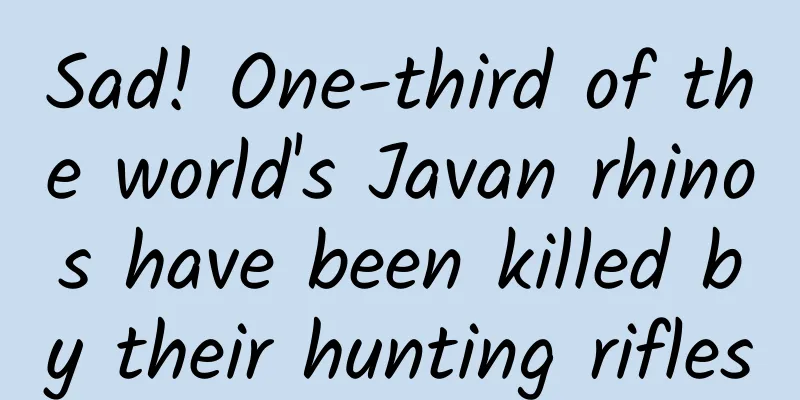Sad! One-third of the world's Javan rhinos have been killed by their hunting rifles

|
Recently, the Indonesian police reported a horrific poaching incident: since 2018, 14 poachers have shot and killed a total of 26 Javan rhinos (Rhinoceros sondaicus). The Javan rhino is one of the most endangered large mammals, with an estimated remaining population of 76 to 82 individuals. In other words, these poachers have killed one-third of the world's Javan rhinos . Ujung Kulon National Park on the island of Java in Indonesia is the only habitat of the Javan rhino. The Javan rhino lives in dense forests and is cautious, making it difficult for people to monitor their survival in real time. Over the past decade, Indonesian officials have only been able to identify individual Javan rhinos through 120 infrared cameras in the park, and have only been able to make a preliminary estimate of their current population size. However, at least 15 of the approximately 80 Javan rhinos have not been photographed in the past three years, which has made Indonesian officials begin to alert to the possibility of unnatural deaths of rhinos. Javan rhinoceros living in Ujung Kulon|Alain Compost / savetherhino.org Since November last year, local police have arrested poachers. One of the 10-member poaching gangs confessed that they had killed at least 22 Javan rhinos, while another 4-member gang killed at least 4. Poachers not only illegally entered Ujung Kulon for long-term field surveys, but also used online travel videos to obtain information about the park, and even found out the locations of several infrared cameras and used official rhino protection equipment to search for rhinos . They shot rhinos with homemade hunting rifles, cut the horns on the spot, and then smuggled the horns to China through middlemen. Currently, the Indonesian police have identified two Chinese buyers. Although some rhino calves were born in these five years and the Javan rhino population should have recovered dynamically, their reproductive efficiency is not high. Hunting up to one-third of the individuals in five years is enough to deal a fatal blow to the Javan rhino population . Conservation efforts race against time against volcanoes The Javan rhino was once widely distributed in eastern India, the countries of the Indochina Peninsula, southwestern China, and the Indonesian archipelago. This species includes three subspecies, but with the destruction of habitats and overhunting, the Indian subspecies (R. s. inermis) became extinct in the early 20th century, and the Vietnamese subspecies (R. s. annamiticus) was also declared extinct when the last female individual was hunted in 2009. Since then, Ujung Kulon National Park on the island of Java in Indonesia has become the last habitat of the Javan rhino . The remains of the last Javan rhino of the Vietnamese subspecies, and the shrapnel remaining on its bones|WWF However, Ujung Kulon National Park is not an ideal "Garden of Eden". Ujung Kulon is located on a narrow peninsula at the westernmost tip of Java Island. 60 kilometers to the north is the famous Krakatoa volcano. In 1883, a violent eruption of the volcano triggered a tsunami that not only claimed the lives of 36,000 people, but also completely destroyed the ecology of the Ujung Kulon Peninsula. The new volcano formed after the eruption and collapse of the volcano is now also extremely active , with strong eruptions in recent years. We cannot speculate when it will cause a regional ecological disaster again, but it is almost certain that it is only a matter of time. Therefore, the conservation of the Javan rhino in Indonesia is almost a race against death. Erupted again in June last year | Indonesia's Center for Volcanology and Geological Disaster Mitigation Agency According to the plans of the Indonesian government and international conservation organizations, the conservation of the Javan rhino will first ensure the stable recovery of the population in Ujung Kulon, and then select healthy adult individuals to rebuild a "backup population" in a different location. However, the restoration of the Javan rhino in Indonesia has been difficult from the beginning. The volcanic eruption in 1883 wiped out the original population. The Javan rhinos living here today are descendants of a few rhinos that later re-immigrated, so the genetic diversity of the population itself is not high. Java Island is also one of the most densely populated areas in the world. Under the pressure of high-intensity human activities, the area suitable for the Javan rhino to live is only about 300 square kilometers, and a considerable area of it is also invaded by the alien species sugar palm (Arenga pinnata). In 1967, Indonesia conducted a preliminary census of the Javan rhinoceros in the park and found only 25 to 30 of them. Although a lot of manpower and funds were invested thereafter, the population grew to 50 to 60 in the 1980s, but the recovery rate slowed down significantly and even regressed at one point. This is probably because the local environment's carrying capacity could no longer support more rhinos. To solve this dilemma, conservationists have made habitat restoration a top priority. With international funding, Indonesian officials hired residents of surrounding communities to clear forests invaded by sugar palms and replant native vegetation to expand habitats suitable for rhinos. Surrounding residents earn income by participating in forest restoration work, which naturally eliminates their enthusiasm for cutting down native forests for land reclamation. In the past decade alone, Ujung Kulon has restored 5,000 hectares of native forests , and the constant appearance of rhinoceros calves in infrared cameras also proves the effectiveness of habitat restoration. Photos of Javan rhinoceros cubs in national parks released by the Indonesian government in 2020 | Ministry of Environment and Forestry, Indonesia With optimism, conservationists have begun to imagine the crucial next step - to find another place to rebuild a habitat of at least 4,000 hectares; to select five males and three females in the breeding stage from Ujung Kulon as "sparks" for ex situ conservation. They speculate that in the next 20 years, the population size of the Javan rhino may be restored to more than 150, gradually escaping the fate of extinction. But at this moment, the sound of poaching gunfire suddenly rang out... Poaching is ignored Why is it that Indonesia has made repeated breakthroughs in Javan rhino conservation, but is unaware of poaching over such a long period of time and on such a large scale? Although rhinos are protected by multiple international conventions, the scale of rhino poaching has not decreased significantly on a global scale. Especially in rhino habitats such as South Africa and Namibia, poaching is still the main factor affecting the recovery of rhino populations. In South Africa alone, 499 southern white rhinos were poached in 2023. Poaching has caused the total size of the world's five rhino species to shrink by 3.7% since 2017. Poached Southern White Rhinos | savetherhino.org Fortunately, there are few reports of poaching of the two rhinos in Indonesia, the Javan rhino and the Sumatran rhino. The last poaching of the Javan rhino dates back to 1998. Some people are optimistic that this is a reflection of Indonesia's effective protection. Indonesia's protection of the Javan rhino is indeed quite comprehensive. In addition to patrolling the land area of Ujung Kulon, there are also maritime patrols to prevent poachers from illegally invading by sea. The road to Ujung Kulon from the outside world was also cut off at the beginning of the establishment of the national park. The 20 years of peace and quiet may have made conservationists believe that poaching has long become a thing of the past. However, looking back today, the fact that Javan rhinoceros poaching has not occurred for many years may just be a fluke in terms of probability. The Javan rhino population is extremely small, and its whereabouts are much more difficult to find than its African relatives. Its low horn is not as easy to exchange for huge profits as the horns of white rhinoceros and black rhinoceros, so it naturally cannot attract the attention of international poaching networks; coupled with the high frequency of local patrols, poaching Javan rhinoceros is not cost-effective. But when local poaching gangs mastered the skills of checking infrared cameras to find rhinos, and the COVID-19 pandemic restricted daily patrols, the risk-benefit ratio of poaching was quietly reversed . A black rhino killed and horned by poachers | the Lewa Conservancy Of course, huge profits are always the core motivation for poaching, and behind it is the strong demand for illegal rhino trade. East Asia has long been one of the core markets for the illegal trade in rhino horns . Unlike ivory, in addition to being used as handicrafts, rhino horns have a stronger demand for "medical purposes", and the "medicinal effects" of rhino horns have evolved from traditional heat-removing to "anti-cancer" in keeping with the times - even if these "medicinal effects" are fictitious, and the composition of rhino horns is actually similar to that of human fingernails. However, the so-called "medicinal effects" have made the intended consumer group of rhino horns more extensive, and not even limited to the wealthy. The demand for these illegal trades not only threatens the five living rhinos, but even the fossilized horns of woolly rhinos buried under the Siberian permafrost have been smuggled for "medicine". The severity of this poaching case also reflects the lack of control over the global poaching network and illegal consumer market, which can easily lead to devastating threats to extremely small populations of species such as the Javan rhino and the Sumatran rhino. Is there still hope for the Javan rhino? Can the badly damaged Javan rhino still see some hope? Perhaps we can still have hope for this tenacious animal. A few years ago, a joint study by China Agricultural University, the University of Copenhagen in Denmark, and Stockholm University in Sweden concluded that large-scale species extinction had occurred in rhinoceros groups before the Pleistocene, and some existing rhinoceros species have experienced and maintained a small population state for a long time, and they have also evolved many characteristics adapted to small populations . Compared with ancient rhinoceroses, the proportion of harmful mutations in existing rhinoceros species is significantly lower, which may be because the current rhinoceros population has tried to eliminate harmful mutations as much as possible through group genetic selection to ensure the health of its small population. Indian rhinoceros living in a national park in India|Itsjustadeep / Wikimedia Commons The conservation case of another one-horned rhino living in Asia, the Indian rhino (R. unicornis), also proves the tenacious vitality of rhinos. In the early 20th century, the Indian rhino population shrank to less than 200 due to threats such as habitat destruction and overhunting; but under the strict protection of the Indian and Nepalese authorities, the Indian rhino has now recovered to about 4,000 . After suddenly losing one-third of its population, the Javan rhino is facing a more severe situation than the Indian rhino. The uncertainty of the volcano also makes it difficult to carry out conservation work slowly. Its fate may really depend on a bit of luck. But in addition to praying for the right time and place, the key to determining its future is to restore confidence as soon as possible, find out the shortcomings of conservation work, and more actively promote population recovery and the introduction of ex-local populations . Specimen of a juvenile Javan rhinoceros in a museum|Peter Maas / Wikimedia Commons This is not just a matter of Indonesia's efforts. Fighting the global illegal wildlife trade network requires the cohesion of all parties, and the ultimate goal is not just to protect the Javan rhino. In the not-so-distant history, China also had traces of Javan rhinos, Sumatran rhinos, and Indian rhinos, and the bronzes cast by our ancestors also left traces of the majestic demeanor of giant beasts. Perhaps, when they finally emerge from the shadow of extinction, they can return to the land of China again and continue their unfinished stories. Author: A man is wandering Editor: Mai Mai |
<<: Unexpected! Gutter oil has become a hot commodity for environmental protection|Bolan Daily
Recommend
Stanford’s latest research: Be careful of “cliff-like aging” at 44 and 60 years old!
The original meaning of "衰" refers to a...
How to find the lever to leverage traffic dividends?
The so-called traffic means acquiring new users. ...
Just three steps to let you play Hammer phone "Big Bang"
Whether it is business office, online social netw...
Double Eleven Pitfall Avoidance Guide: Teach you how to see through the e-commerce likes routine
The annual Double Eleven is coming soon. Are thos...
Ninebot E-Series Test Drive Experience: This is what a motorcycle should look like in the Internet era
In recent years, with the deteriorating environme...
[Case] How does an e-commerce app develop an operation and promotion strategy from scratch?
Through this article, you can learn how to formul...
#千万IP创科普# Can you tell by the legs? The Minnan people teach you how to distinguish the "three cephalopod brothers"
📙Reading tips: The content comes from the diction...
49-inch LG original IPS Coocaa K49 new product unboxing review
Recently, Coocaa, an Internet TV brand under Skyw...
"SARFT's game approval authority has been cancelled" is a misunderstanding of the policy
On August 13, the State Council announced a new b...
Guiyang SEO Training: How can SEO novices avoid optimization mistakes?
How can SEO novices avoid optimization misunderst...
Teach you how to quickly get 99 points in event planning
Writing event strategy plans is the basic skill o...
A generation of legendary phones is finally abandoned? iOS 16 may remove support for iPhone 6S/SE
You should know that in addition to the two hardw...
How can Toutiao quickly gain millions of followers? Here are 10 effective routines
With the rise and prosperity of the mobile Intern...
Marketing lifeline: Super conversion rate strategy!
Adults can only accept the conclusions they draw....









